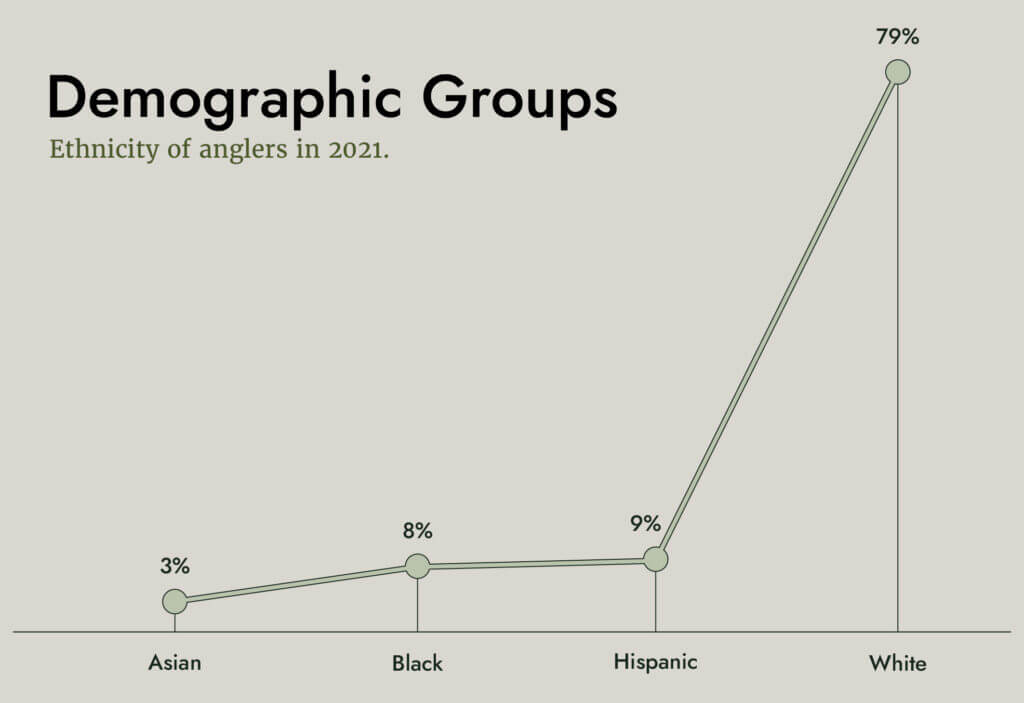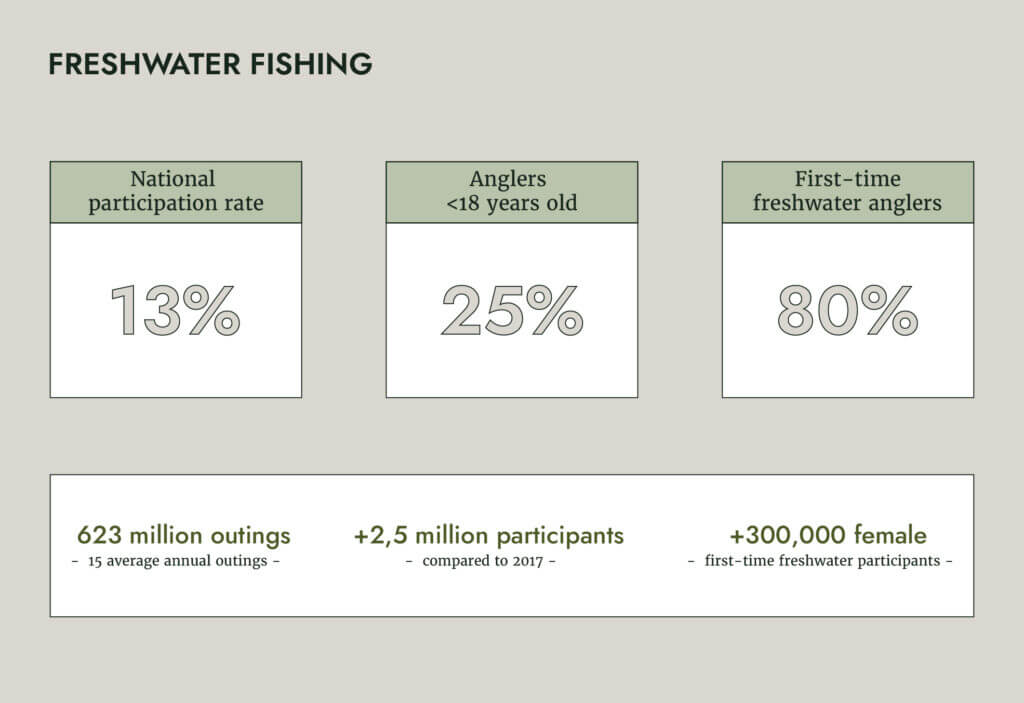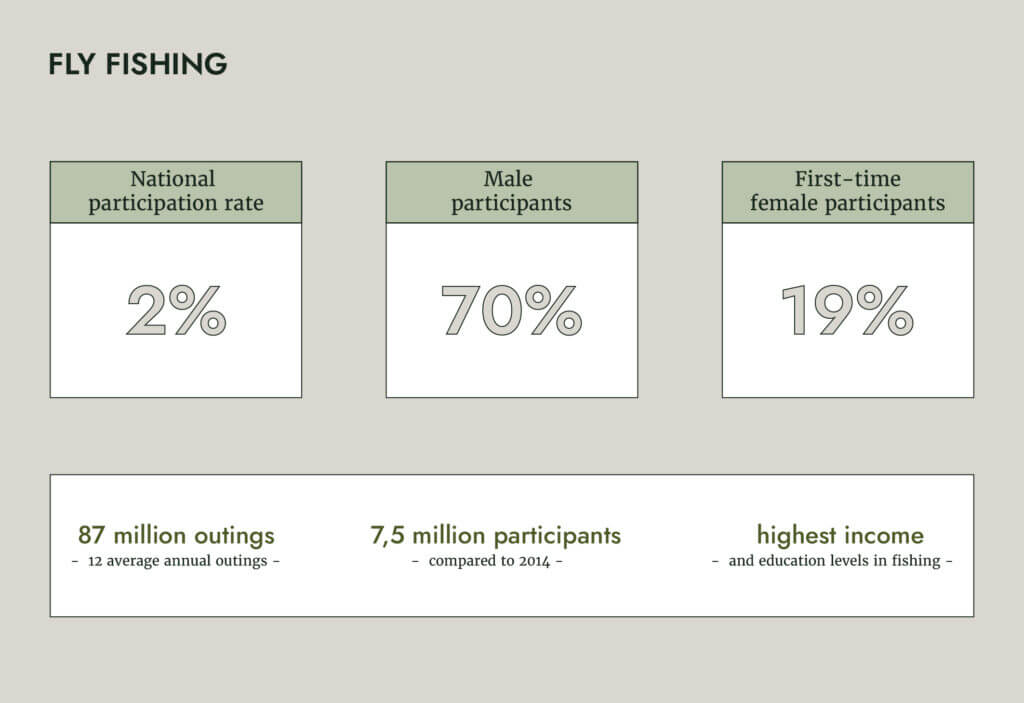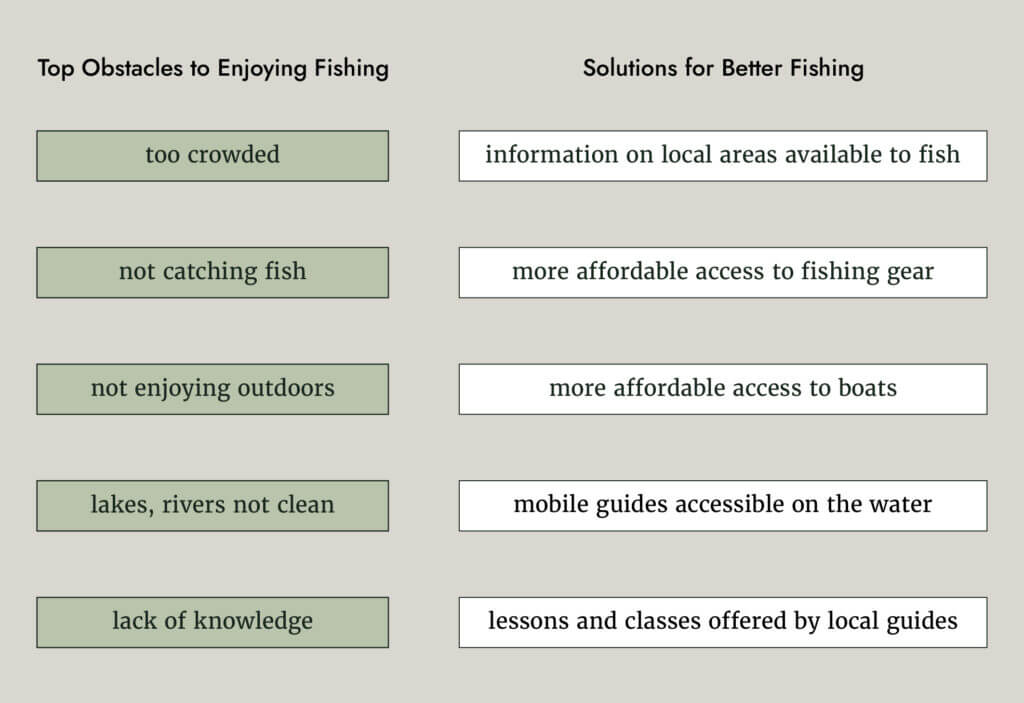Recreational Fishing Statistics
By: Madison Kopta | [lmt-post-modified-info]
Fact Checked | Cite this Webpage
Report Highlights – Fishing Statistics in the U.S.
-
- 55 million fishermen in the U.S.
-
- 81% of fishing takes place in freshwater
-
- 7.9 million children between ages 6-12 went fishing in 2021 alone
-
- Recreational fishing-related expenditures in 2011 were about $9.6 billion industry
-
- 37% of fishermen were women
-
- Saltwater fishing is the most diverse – 3 in 10 were non-white participants
Table of Contents
How Many People Fish in the U.S.
Based on the most current statistics, the number of fishermen in the U.S. is 52.4 million. In 2021 52.4 million Americans went fishing which is 2.4 million fewer than the year before.
This translates to a 17% National Participation rate, down from 18% in 2020.
Locations to fish in The United States did see a remarkable rise in 2021 in one factor with the record-breaking number of female participants.
Demographics of Fishermen
Age of Fishermen
The rising number of young and elderly participants in events is a trend that has been gaining steam for the past ten years.
In 2021, approximately one in four event participants were either children aged 6 to 17 or seniors over 55, indicating an increased segmentation in the population of those participating.
This marks a contrast from a decade prior when only one in five eventgoers fell within these age groups.

-
- 15% Ages 6-12
-
- 9% Ages 13-17
-
- 8% Ages 18-24
-
- 14% Ages 25-34
-
- 14% Ages 35-44
-
- 14% Ages 45-54
-
- 13% Ages 55-64
-
- 11% Ages 65+
Gender of Fishermen
According to recent studies, 19.4 million women had taken up fishing, making up 37% of the total anglers–underscoring the highest level since fishing started being tracked.
Despite this awesome feat, men still make up the majority of anglers at 63%. However, this is still an extraordinary stride towards achieving gender equality in recreational fishing.
-
- 19.4 million women went fishing, and their participation made up 37% of the total anglers.
-
- 63% of all anglers were male.
Ethnicity of Fishermen
There were notable discrepancies within specific demographics:
-
- Hispanic participants made up 9% of fishing participants, compared to 18% of the country as a whole;
-
- Black anglers accounted for 8% while they make up 12% nationally;
-
- only 3% of anglers were Asian versus 6% nationally.
Overall, 78% of participants in 2021 were White, whereas that figure is just 60% when looked at through a wider lens.
Despite overall numbers being balanced towards the larger demographic groups, these gaps are worth further exploration.

-
- 79% of anglers were White
-
- 9% of fishing participants were Hispanic
-
- 8% were black
-
- 3% were Asian
Income of Fishermen
Recent studies collected data to analyze the amount of money spent on recreational fishing in the US.
The results showed that 28% of all anglers earned over $100,000 yearly, and this large group was supported by the other percentages: 14% made between $75,000-$99,999, 19% made between $50-$74,999, and 22% earned between $25,000-49,999 annually.
Lastly, 16% of anglers fell below the mark of $25,000.
These numbers provide a picture of the amount individuals invest in fishing for leisure in the United States.

-
- Anglers earning $100,000 yearly made up the largest group at 28%
-
- $75,000-$99,999 made up 14%
-
- $50.000-$74,999 Made up 19%
-
- $25,000-49,999 Made up 22%
-
- ≤$25,000 Made up 16%
Location of Fishermen
The fisheries of the United States in the South Atlantic region, including places like Florida and Georgia, saw the most participation in 2021. This accounts for approximately 22% of all fishing trips nationwide.
Meanwhile, areas like New England, including states such as Maine and Massachusetts, had only 4% of anglers nationwide.
East North Central saw states around the Great Lakes, with 12% of its residents angling in 2021, which made it the second-largest fishing location in the U.S.
States in the West South Central locations, such as New Mexico, Arizona, and Texas, saw 11% of the population fishing, which followed closely behind the Pacific region, with California, Oregon, and Washington seeing 11%.
-
- The South Atlantic region, places like Florida and Georgia, saw the most fishing at 22%.
-
- New England saw the smallest amount of fishing at 4% nationwide.
Fishing Statistics For Kids
The most recent fishing statistics show that more kids are getting out on the water than ever before, with a total of 5 million participants.
The number of outings for adolescent anglers has risen by over 700 thousand since 2019, reaching 84 million outings in 2021.
That translates to an average of 18 annual outings per adolescent angler.
-
- 5 million adolescent fishing participants ages 13 to 17
-
- 24% national participation rate
-
- 18 average annual outings
-
- +700k adolescent participants
Fishing by Type
In 2021, four out of every five first-time fishers decided to venture into freshwater locations. The percentage of participants choosing saltwater species of fish saw only a slight increase compared to previous years.
When it comes to where Americans fish, there is minimal overlap between freshwater fishing and saltwater fishing.
Less than one in five anglers reported fishing in more than one type of water and style. This ratio has remained unchanged for the last decade.
· 82% participated in one type of fishing
· 18% participated in multiple types of fishing
Fly fishing had a slight dip in participation numbers in 2021 compared to 2020.
However, the bigger picture shows that it’s still a growing pastime, with nearly one million more participants now than a decade ago.
-
- Freshwater fishing- 81%
-
- Saltwater fishing– 16%
-
- Fly fishing – 3%
Freshwater Fishing Statistics
2021 saw 40.9 million freshwater fishing participants overall, which is lower than previous years but still higher than 2019’s 37.7 million participants.
This puts the national participation rate at 13%, which is an impressive figure.
Though first-time freshwater participants declined to 2.7 million this year, that number still easily topped pre-COVID numbers from 2020 (2.3 million).
The numbers also show that there were 623 million total outings related to freshwater fishing, with each angler making an average of 15 trips per year which is a slight increase from 2017’s 14 trips per year average.
Of those participating in freshwater fishing, 25% were under 18, and 300 thousand more female first-time participants were reported in 2021 than in 2016.

-
- 13% national participation rate
-
- 623 million outings
-
- 15 average annual outings
-
- +2.5 million more participants than in 2017
-
- 25% of freshwater anglers were under 18
-
- 80% of first-time anglers went freshwater fishing
-
- 300k more female first-time freshwater participants in 2021 than in 2016
Saltwater Fishing Statistics
13.8 million people enjoyed marine fisheries in 2021.
180 million saltwater fishing outings last year, with an average of 13 annual outings per person – which is a +3% average annual growth in participants over the past three years.
Saltwater fishing had the most diverse participant base compared to other types of fishing. Hispanic, Black, and Asian American participants accounted for 12%, 11%, and 5%, respectively, making up 30% of total saltwater participants.
In 2021, the number of females, children ages 6-17, and those over 65 also grew.
-
- 13.8 million saltwater participants
-
- 5% national participation rate
-
- 180 million outings
-
- 13 average annual outings
-
- +3% average annual growth in participants over the past three years
-
- Most diverse- 3 in 10 were non-white participants
Fly Fishing Statistics
Fly fishing has been seeing steady participant growth since 2014. Even with a 4% decline in 2021, there are still 7.5 million fly-fishing participants, making it one of the most popular outdoor activities today.
There are some interesting stats that can be found when looking at these participants, including gender and income levels.
Fly fishing is the most male-dominated fishing category, with 70% of its participants being male, a distinction it has held since participation data was first collected 15 years ago.
It also had the highest income and education level, with 39% of participants reporting annual household income over $100,000 and 60% completing at least some college education.
The number of outings for fly fishing was 87 million in 2021, and the average annual outings per participant were 12, making it one of the fastest-growing categories for average annual growth rate in participants over the past three years.
When looking at female participation specifically, 19% reported being first-time anglers in 2021—a 6% increase from 2020—which could mean that more women are becoming interested in taking up fly fishing as their new hobby or sport.

-
- 7.5 million fly fishing participants
-
- 2% national participation rate
-
- 87 million outings
-
- 12 average annual outings
-
- The fastest average annual growth rate in participants over the past three years
-
- Highest income and education levels in fishing
-
- 19% of female participants were first timers
Barriers to Recreational Fishing
It turns out that barriers influence how many people in the U.S. fish.
While a few reduce the number of people who fish, including access to fishing equipment or expenses such as registering for a fishing license, there is an even bigger one.
Crowds were reported to be the biggest concern for people, leading to being the number one barrier to fishing.
Crowds can be intimidating to first-time anglers due to the number of people often found in specific fishing locations.
Studies conducted in recent years have revealed that overcrowding and overfishing in areas put most fishermen off, making it their number one barrier when it comes to fishing.

Top Obstacles to Enjoying Fishing
-
- Too Crowded
-
- Not Catching Fish
-
- Not enjoying the outdoors
-
- Unclean lakes, rivers, etc
-
- Too expensive
When asked what helped increase fishing enjoyment, the number one suggestion was having more information and resources available from local fishery management agencies and the U.S. Fish and Wildlife Service on where good fishing locations are.
Solutions for Better Fishing
-
- More information on local areas available to fish
-
- More affordable access to fishing gear
-
- More affordable access to boats
-
- Mobile guides accessible on the water
-
- Lessons and classes offered by local guides
The Future of Fishing
-
- 99% of participants plan to fish this upcoming year again
-
- 40% plan 8 to 20 outings, up from 27% in 2020
-
- 32% plan more than 20 outings, up from 27% in 2020
Fishing has seen an increasing surge in popularity, even amidst challenging times.
Those new to the sport cite friends or family as significant influencers in their decision to fish, many of whom had already been active participants for some time.
Beyond the encouragement from others, many cite excitement, easy access to quality fishing spots, and creative forms of recreation that also allowed them to remain socially distanced during the lockdowns in 2021 due to the pandemic.
Nearly all prior participants plan on fishing within the coming year, with 32% planning more than twenty trips and 40% planning 8-20 excursions – higher rates than in 2020.
This marks a significant shift for the fishing hobby and its promising prospects for the future.
Final Thoughts
Although recent recreational fishing statistics show interest wanes and rises with different trends, taking care of our natural resources will always be important.
By taking care of fisheries and investing in programs that help local aquatic management, we can improve the experience for everyone while keeping any negative economic impact for the fishing industry to a minimum.
